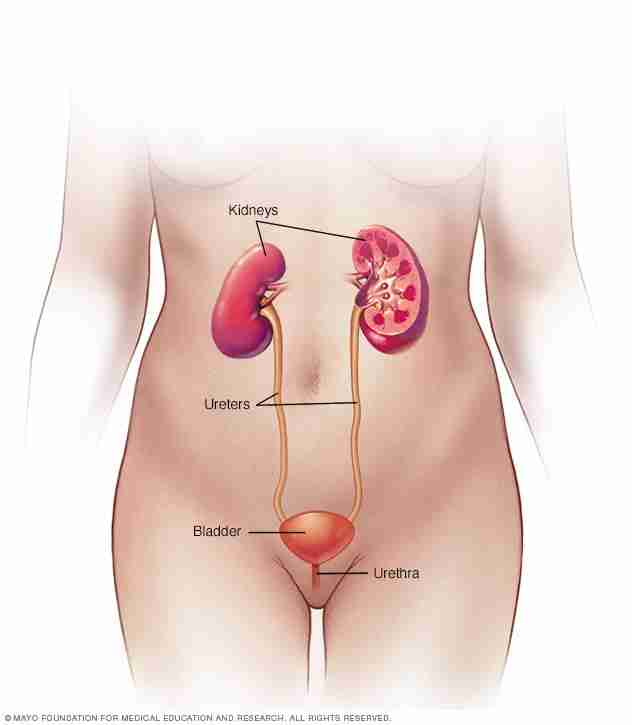Overview
Normal urine color ranges from pale yellow to deep amber — the result of a pigment called urochrome and how diluted or concentrated the urine is.
Pigments and other compounds in certain foods and medications can change your urine color. Beets, berries and fava beans are among the foods most likely to affect the color. Many over-the-counter and prescription medications give urine vivid tones, such as red, yellow or greenish blue.
An unusual urine color can be a sign of disease. For instance, deep red to brown urine is an identifying characteristic of porphyria, a rare, inherited disorder of red blood cells.
Products & Services
Symptoms
Normal urine color varies, depending on how much water you drink. Fluids dilute the yellow pigments in urine, so the more you drink, the clearer your urine looks. When you drink less, the color becomes more concentrated. Severe dehydration can produce urine the color of amber.
But urine can turn colors far beyond what's normal, including red, blue, green, dark brown and cloudy white.
When to see a doctor
Seek medical attention if you have:
-
Visible blood in your urine. Bloody urine is common in urinary tract infections and kidney stones. These problems usually cause pain. Painless bleeding might signal a more-serious problem, such as cancer.
-
Dark or orange urine. If your urine is dark or orange — particularly if you also have pale stools and yellow skin and eyes — your liver might be malfunctioning.
Causes
Female urinary system

Female urinary system
The female urinary system — which includes the kidneys, ureters, bladder and urethra — is responsible for removing waste from the body through urine. The kidneys, located in the rear portion of the upper abdomen, produce urine by filtering waste and fluid from the blood.
Male urinary system
Male urinary system
The male urinary system — which includes the kidneys, ureters, bladder and urethra — is responsible for removing waste from the body through urine. The kidneys, located in the rear portion of the upper abdomen, produce urine by filtering waste and fluid from the blood.
Discolored urine is often caused by medications, certain foods or food dyes. In some cases, though, changes in urine color can be caused by specific health problems.
The color categories here are approximate, because what looks like red to you might look like orange to someone else.
Red or pink urine
Despite its alarming appearance, red urine isn't necessarily serious. Red or pink urine can be caused by:
-
Blood. Factors that can cause urinary blood (hematuria) include urinary tract infections, an enlarged prostate, cancerous and noncancerous tumors, kidney cysts, long-distance running, and kidney or bladder stones.
-
Foods. Beets, blackberries and rhubarb can turn urine red or pink.
-
Medications. Rifampin (Rifadin, Rimactane), an antibiotic often used to treat tuberculosis, can turn urine reddish orange — as can phenazopyridine (Pyridium), a drug that numbs urinary tract discomfort, and laxatives containing senna.
Orange urine
Orange urine can result from:
-
Medications. Medications that can turn urine orange include the anti-inflammatory drug sulfasalazine (Azulfidine); phenazopyridine (Pyridium); some laxatives; and certain chemotherapy drugs.
-
Medical conditions. In some cases, orange urine can indicate a problem with your liver or bile duct, especially if you also have light-colored stools. Dehydration, which can concentrate your urine and make it much deeper in color, can also make your urine appear orange.
Blue or green urine
Blue or green urine can be caused by:
-
Dyes. Some brightly colored food dyes can cause green urine. Dyes used for some tests of kidney and bladder function can turn urine blue.
-
Medications. A number of medications produce blue or green urine, including amitriptyline, indomethacin (Indocin, Tivorbex) and propofol (Diprivan).
-
Medical conditions. Familial benign hypercalcemia, a rare inherited disorder, is sometimes called blue diaper syndrome because children with the disorder have blue urine. Green urine sometimes occurs during urinary tract infections caused by pseudomonas bacteria.
Dark brown or cola-colored urine
Brown urine can result from:
-
Food. Eating large amounts of fava beans, rhubarb or aloe can cause dark brown urine.
-
Medications. A number of drugs can darken urine, including the antimalarial drugs chloroquine and primaquine, the antibiotics metronidazole (Flagyl) and nitrofurantoin (Furadantin), laxatives containing cascara or senna, and methocarbamol — a muscle relaxant.
-
Medical conditions. Some liver and kidney disorders and some urinary tract infections can turn urine dark brown.
-
Extreme exercise. Muscle injury from extreme exercise can result in pink or cola-colored urine and kidney damage.
Cloudy or murky urine
Urinary tract infections and kidney stones can cause urine to appear cloudy or murky.
Risk factors
Discolored urine that isn't the result of foods or medications could be caused by a medical condition that affects urine color. Factors that put you at risk of medical conditions that can affect urine color include:
-
Age. Tumors of the bladder and kidney, which can cause blood in the urine, are more common in older people. Men older than 50 occasionally have urinary blood due to an enlarged prostate gland.
-
Family history. A family history of kidney disease or kidney stones makes it more likely that you'll develop these problems. Both can cause blood in the urine.
-
Strenuous exercise. Distance runners are most at risk, but anyone who exercises vigorously can have urinary bleeding.
Oct. 27, 2017